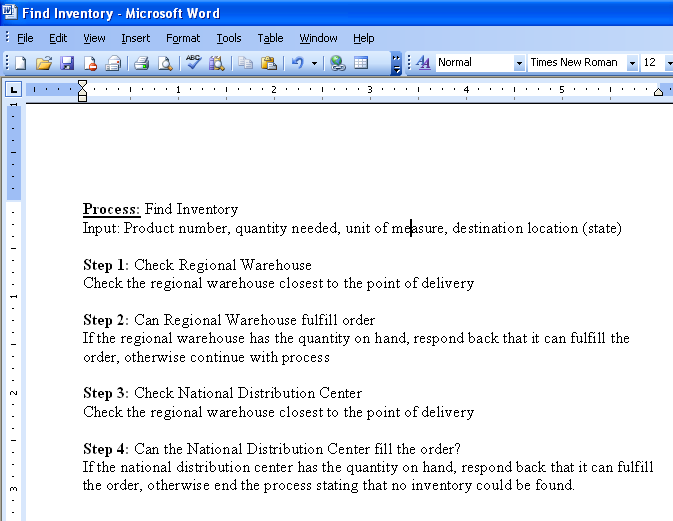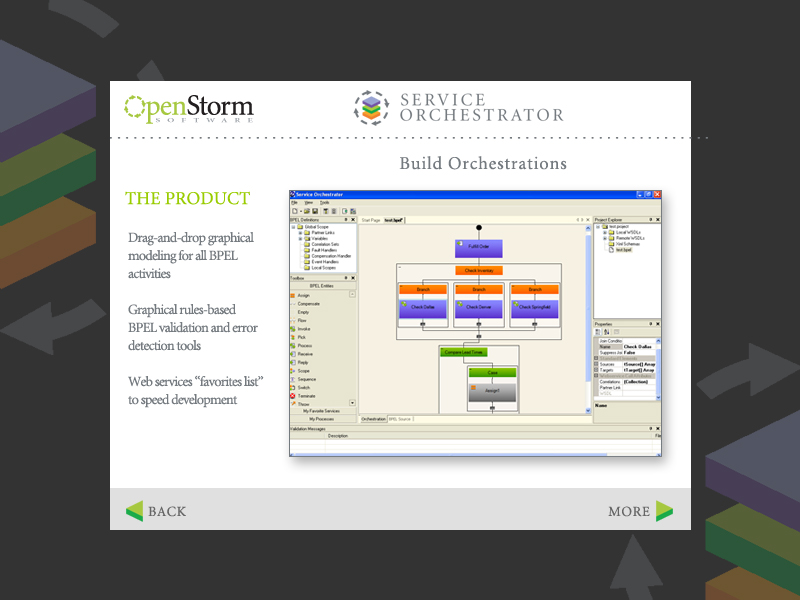| Service Oriented Enterprise |
|
Friday, January 30, 2004 Microsoft on RFID From the RFID Journal, see: http://www.rfidjournal.com/article/view/779/1/1/ posted by jeff | 7:32 AM Process Contracts The concept of 'design by contract' was made popular in the object oriented world - or perhaps more precisely, in the component-oriented world. Much of the work that went into this study was centered around making a single module adhere to a contract and adhere in a consistent manner. When the Java language was introduced many people bumped into the 'interface' for the first time. This was the vehicle that guaranteed 'what' an object could do, but not 'how' it would be done. This concept was extended with WSDL. The extensions included: defining the interface in a language neutral manner, allowing for multiple bindings between interface and implementation, allowing for a more message-centric design of parameters / arguments, strong support for remote calls and declaration of quality attributes as declarative policies (reliability, integrity, etc.) In the process world, we continue to leverage the 'design by contract' mentality. Languages like BPEL expose themselves to the outside world through WSDL. This means that every process IS A service with a contract. In addition, BPEL makes all external calls VIA web services. Thus, all calls are first described via the contract. As we continue to find best practices in designing BPEL code, we have tested a variety of means to get from concept to delivery. The one that seems to be getting the most ground is what we are calling 'process contracts'. Here, the analyst takes on a 'RAD' view of the process. The goal isn't to get all the detail right on the first pass, but rather to quickly identify all of the service calls that need to be made to compose the process. You can think of this almost like the old CRC exercises (Classes, Responsiblity, Collaboration) - except replace 'classes' with 'service calls'. One thing that is becoming apparent is that people want to use BPEL in different ways. I usually put the usage scenarios into one of three different buckets: B2B, A2A and composite applications. In the B2B and the A2A scenario, it is common for the endpoints to already exist, but the contract to the service (type, message, operations) still needs to be created. In the 'composite apps' space, it is common for neither an interface nor an implementation to exist. In any scenario, the designer finds that they quickly need to begin creating the interfaces or contracts. We are finding that most people are comfortable building out a complete process by 'stubbing' out the process. This involves identifying all of the major steps (service calls) and the flow/logic between the steps. At this point, the designer isn't going into any detail about the step, just putting boundaries around 'what it does'. The designer then goes back and starts to add detail around the contract of each call. This involves detailing out the WSDL interface (not binding and service). Here the designer begins to look at using common messages and types for consistent service calls. As the designer prepares the calls for invocation, he/she will usually begin to identify if the scope of the call is correct. This is a byproduct of identifying the 'fattiness' of the message, the 'chattiness' of the calls, etc. All of this is happening up front - meaning it is happening before we begin to 'program in the small' via your favorite language to program services: Java, C#, etc. Upon completion of the process contract, you will have identified: 1. The interface to the process itself 2. The division of labor between the services 3. The interface for each service called 4. Verification that the data needed to call each service is available to the service (var scopes) It is at this point where you can begin working with your service implementer (java guy, etc.). Here is how the conversation goes: Jeff: "Hey Bob, I just finished my process contract for the new Fulfill Order process." Bob: "Cool. How many service calls?" Jeff: "Well, there were a total of 8 calls. 3 of them were canned and I will be sucking them out of UDDI, but 5 of them are new." Bob: "Did you stub out the 5 new ones?" Jeff: "Yea.. I did my best. I'll email you the BPEL and WSDL's" Bob: "Better yet.. just check your process into version control and I'll pick it up there" Jeff: "Good thinking. Will do. How long do you think it will take for you to turn around the implementations?" Bob: "Jeff, I have no idea - I haven't even seen the WSDL's yet! Let me take a look and I'll get back to you..." Jeff: "Understood. I'm going to move on to the Replenish Inventory process." Bob: "Sounds good - I should have estimates in a few hours." This conversation - and this style probably already feel familiar. The one thing that is improved is that in many cases, the process contract will become a new deliverable in the development cycle. It will force a more structured deliverable to come out of the late analysis or early deisign stage and may likely result in a more timely delivery of the end product. posted by jeff | 6:03 AM Thursday, January 29, 2004 Structured Process Cases I've been playing with variations of the "Use Case" that are more process-centric and contract oriented. Overall, I think there is a good match between capturing process descriptions from an analysis perspective and tying that information back to the BPEL. Although this is a very incomplete example, consider the following. A Process Analyst sits in front of their favorite tool (Microsoft Word) and writes down the name of the process, a small description and a handful of steps:  Now, the analyst adds a schema (or two) to the Word 2003 document by pulling up the "Tools: Templates and Add-Ins" window. In the example I'm using, they are adding in the BPEL schema but it might likely be a higher-level (more abstract) grammar that they choose.  Now, the analyst goes back to the document and "paints structure" into the content. This assumes that the analyst is given some extra training in such a process (think UML like training, "Process Case").  After painting the structure around the Process Case, the user is able 'hide xml' so that it looks like a normal requirements document. The analyst then takes the 'requirements' and sends it off to development. But, since it was 'painted' with a well known schema, the developer merely uploads the requirements document directly into their orchestration tool which stubs out the entire process for them. Now, of course there will be mismatches in syntax and scope, but the developer will make the changes and forward back the structured document for approval to the analyst. At the same time, the developer will be creating a vocabulary of services. These will be marked up in WSDL (service:operation). Imagine terms like "checkInventory", "fillOrder", etc. These terms will then be made available to the analyst to drop into their future requirements documentation. By repeating this process, the links between analysis and design will continue to grow in strength. This is still an early concept but our early tests indicate that we can significantly reduce development / integration costs by using the aforementioned closed-loop mechanism. posted by jeff | 7:20 AM Wednesday, January 28, 2004 A first peek... In the last few months, I've had hundreds of inquiries about the next version of the OpenStorm orchestration product. And although we are still in limited beta of the 2.0 release, I thought I'd share a single slide from the new deck. The new product has a great feel to it, with some really interesting features. This is a shot of the main orchestration canvas, where you paint your process flow.  I'll post a bit more later on the product. Thanks to all of the people who have guided us through the endeavor and worked with us on the feature / function tradeoffs! posted by jeff | 10:47 PM |
|
|||||||||||||||
|
|
||||||||||||||||